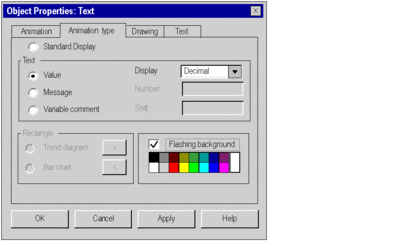At a Glance
All the graphic objects (simple or compound) that you create in a screen can be animated. This tab is used to set the animation type which depends on the nature of the graphic object to be animated:
to select the object’s display mode,
to select the display mode of the text linked to the object,
to select flashing option,
to select the trend diagram mode,
to choose bar chart mode.
Animation type attributes setting screen
The following below is used to set the animation type attributes of a graphic object.

Description
The table below describes the settings that you may define.
Field |
Description |
|---|---|
Standard Display |
The object is displayed with its attributes if this button is selected. |
Value |
The value taken by the variable is displayed according to the display mode chosen. In offline mode, even if this animation style is selected, the text defined in the Text field of the object is displayed on the screen with the selected font and size. |
Display |
Choice of display mode:
When the length of the object’s definition zone is too small to display the value, the field is filled with # characters. The font used is the one defined in the Text tab. If the animation variable is of the String type (string of characters), the Display field cannot be accessed because viewing is automatically in ASCII. |
Message |
You must select this button to display a message configured in the Operator screens messages editor. The Number field allows you to enter either a message number, or the term Val. In the last case, the displayed message will be the one whose value is contained in the variable associated with the object. The Shift field allows you to enter a value that will be added to the one contained in the variable. |
Variable comment |
If this button is selected and if the text animation condition is met, the comment associated with the variable is displayed. Note: This function allows, among other things, to avoid a double entry. Enter the comment once in the variables editor. This will be used as a message linked to the variable. |
Trend diagram |
You may use rectangle type objects such as trend diagrams. Selecting this box will give you access to the trend diagram’s parametering box. |
Bar chart |
You may use rectangle type objects such as bar charts. Selecting this box will give you access to the bar chart’s parametering box. |
Flashing background |
When this box is selected and if the display condition is met, the background of the graphic object flashes according to the user-specified flashing color. |
Properties
The table below shows the types of animation that may be associated with the driving objects.
Object |
Standard |
Value |
Message |
Trend diagram |
Bar chart |
Flashing |
|---|---|---|---|---|---|---|
Line |
X |
- |
- |
- |
- |
X |
Rectangle |
X |
- |
- |
X |
X |
X |
Ellipse |
X |
- |
- |
- |
- |
X |
Curve |
X |
- |
- |
- |
- |
X |
Polygon |
X |
- |
- |
- |
- |
X |
Text |
X |
X |
X |
- |
- |
X |
Compound object |
X |
- |
- |
- |
- |
- |
Image |
X |
- |
- |
- |
- |
- |
Control |
X |
- |
- |
- |
- |
- |
Legend: |
||||||
X: Yes - : No |
||||||


